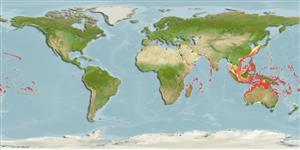Actinopterygii (ray-finned fishes) >
Beryciformes (Sawbellies) >
Holocentridae (Squirrelfishes, soldierfishes) > Holocentrinae
Etymology: Sargocentron: Greek, sargos = sargus + Greek, kentron = sting (Ref. 45335).
Environment / Climate / Range
Ecology
Marine; reef-associated; depth range 1 - 122 m (Ref. 9710). Tropical, preferred 27°C (Ref. 107945); 35°N - 38°S, 29°E - 128°W
Indo-Pacific: Red Sea and East Africa (Ref. 4201) to the Hawaiian and Ducie islands, north to southern Japan, south to Australia; throughout Micronesia.
Size / Weight / Age
Maturity: Lm ? range ? - ? cm
Max length : 51.0 cm FL male/unsexed; (Ref. 40637); common length : 35.0 cm TL male/unsexed; (Ref. 5450); max. published weight: 2.6 kg (Ref. 40637)
Dorsal
spines
(total): 11;
Dorsal
soft rays
(total): 14-16;
Anal
spines: 4;
Anal
soft rays: 9 - 10. Head and body red, scale edges silvery white; spinous dorsal crimson in color; other fins orange-yellow; vertically oblong crimson spot on preopercle behind eye (Ref. 4201). Five oblique scale rows on cheek; body depth 2.4-2.6 in SL; head length (HL) 2.55-2.85 in SL; lower jaw when closed slightly to moderately projecting; snout length 3.0-3.8 in HL larger than orbit diameter in adults; interorbital width 6.3-8.7 in HL; maxilla extending posteriorly to a vertical at front edge of the orbit; anterior end of nasal bone often with 2 close-set, short spines; medioposterior margin of nasal bone spineless; large nasal fossa spineless on margin; slight ridge of upper edge of suborbital bones weakly serrate; 2 subequal opercular spines; long preopercular spine, usually greater than orbit diameter in specimens at least 20 cm SL; 3rd or 4th dorsal spine longest, 1.7-2.3 in HL; 3rd anal spine 1.7-2.3 in HL (Ref. 27370).
A solitary species that inhabits a variety of reef zones from reef flats to lagoon and seaward reefs to a depth of at least 122 m and is fairly common in areas not subjected to heavy spear fishing. Found under ledges during the day (Ref. 9710). Benthopelagic (Ref. 58302). Largest species of squirrelfish and the highest-bodied Sargocentron (Ref. 37816). Juvenile inhabits shallow protected reefs. A nocturnal species that feeds on crabs, shrimps and small fishes. Spine of preopercle venomous. Largest squirrelfish (Ref. 48635).
Life cycle and mating behavior
Maturity | Reproduction | Spawning | Eggs | Fecundity | Larvae
Randall, J.E., 1998. Revision of the Indo-Pacific squirrelfishes (Beryciformes: Holocentridae: Holocentrinae) of the genus Sargocentron, with descriptions of four new species. Indo-Pac. Fish. (27):105 p. (Ref. 27370)
IUCN Red List Status (Ref. 115185)
CITES (Ref. 94142)
Not Evaluated
Threat to humans
Reports of ciguatera poisoning (Ref. 2334)
Human uses
Fisheries: minor commercial; aquarium: public aquariums
More information
Common namesSynonymsMetabolismPredatorsEcotoxicologyReproductionMaturitySpawningFecundityEggsEgg development
ReferencesAquacultureAquaculture profileStrainsGeneticsAllele frequenciesHeritabilityDiseasesProcessingMass conversion
Tools
Special reports
Download XML
Internet sources
